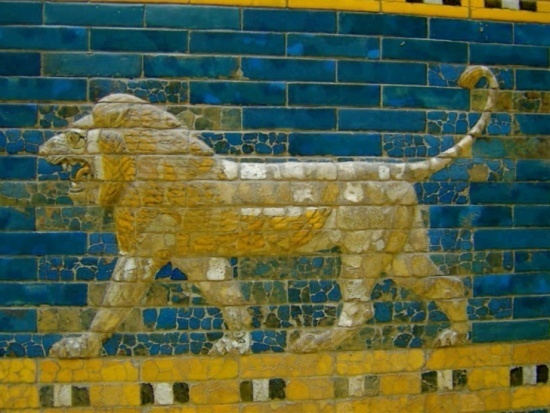"A Little Horn" -- Daniel 8:1-27
 Wednesday, October 11, 2017 at 01:17PM
Wednesday, October 11, 2017 at 01:17PM 
The Fifteenth in a Series of Sermons on the Book of Daniel
Who is Antiochus IV Epiphanes and why should we care? If we were Jews we would know the answer to this question immediately–Antiochus Epiphanes and the Macabbean Wars are the historical background of the Jewish holiday “Hanukkah” (which means “dedication,” or more specifically, “re-dedication”). The reason why we as Christians should care about Antiochus is because the prophet Daniel had a vision (a second, which is recounted in chapter 8), this time of a ram and a goat. But the “little horn” also reappears and his role is central in this vision, pointing us ahead to a future Antichrist. In this visionary dream, YHWH gives Daniel a prediction of yet another terrible time for the people of God then exiled in Babylon. This vision informs them that at some point before the dawn of the messianic age, yet after the exiles have indeed returned from Babylon to Judah to rebuild the city of Jerusalem and YHWH’s temple, the rebuilt temple will be desecrated by a “Little Horn,” who, in this vision, is none other than Antiochus IV Epiphanes. The temple will be cleansed and the altar rebuilt by Judas Maccabaeus, the famed Jewish rebel leader who recaptured Jerusalem from Antiochus’ forces and then restored the temple. This event, celebrated by Jews ever since (“Hanukkuh”), was foretold with uncanny accuracy by Daniel, and recounted for us in the 27 verses of the eighth chapter of the Book of Daniel.
This vision is important to us for a number of reasons, not the least of which is the accuracy of Daniel’s prediction of yet another terrible desecration of YHWH’s temple in Jerusalem. This desolation will occur long after the Jewish exiles then held in Babylon (at the time Daniel is given this vision), have, in the future, returned to Judah and are once again established in the land of promise. Daniel’s vision predicts the coming of Antiochus IV Epiphanes (some 350 years yet future to Daniel), but it also depicts him as a type (or a foreshadowing) of series of antichrist figures yet to come. As we saw in the vision recorded in Daniel 7, this series of antichrists includes the self-deifying emperors of Rome (the “Little Horn” of the fourth beast of the visions in Daniel 2 and 7), and which culminates in a final end times Antichrist foretold by the Apostle Paul in 2 Thessalonians 2, our New Testament lesson.
As I have mentioned throughout our time in Daniel, critical scholars will simply not accept miraculous predictive prophecy, so they argue, a unnamed Jew living in Judah, writing as the “prophet” Daniel composed this book and at some point shortly after the Maccabean Wars (after 167 BC), because, critical scholars say, Daniel’s prophecy is far too accurate to have been given three and a half centuries prior to the events foretold. Yet Jesus, John, and Paul see Daniel’s visions as predictive prophecy with Jesus applying to himself the title “Son of Man” in the Olivet Discourse, John seeing Daniel’s fourth beast and its “Little Horn” as the Roman empire (Nero in particular), while Paul sees the “Little Horn” as a foreshadowing of an end-times Antichrist (the “man of sin”) and a final apostasy.
In order to fully appreciate the significance of Daniel’s vision in chapter 8, we begin with the historical events which Daniel predicted, before we take up the details of the prophecy. We do this to better understand the accuracy of the events foretold in Daniel’s vision. We begin with a brief history of Jewish temple from Daniel’s time until the days of the Maccabees. Then we will consider the career of Antiochus IV Epiphanes and the Maccabean wars of 168-160 BC, before turning to Daniel’s vision (vv. 1-27 of chapter 8), which, as we will see, predicts these events in remarkable detail and accuracy.
As for the Jerusalem temple, as we saw throughout our study of Ezra-Nehemiah, the temple was destroyed by Nebuchadnezzar in 587 BC. Many of the Jewish inhabitants of Judah and Jerusalem were taken into exile in Babylon. Daniel had been take captive in 605 BC, so he was present when these exiles arrived in Babylon. No doubt, he heard first hand accounts of the destruction of Jerusalem and the temple. Daniel also knew the prophecy of Jeremiah (specifically Jer. 25:11-12) in which the prophet foretold that the Jews would remain in exile in Babylon for 70 years. We have seen in the first half of Daniel’s prophecy (chapters 1-6), that Daniel lived until the Jews were released to return home by Cyrus (Darius the Mede) in 538 BC. We also know from Ezra and Nehemiah that work on rebuilding the temple begun under Zerubbabel and was finally completed in 516 BC–the so-called “second” temple. During the days of Nehemiah, Jerusalem’s walls were rebuilt and dedicated to YHWH in 444 BC.
To read the rest of this sermon: Click Here


Reader Comments